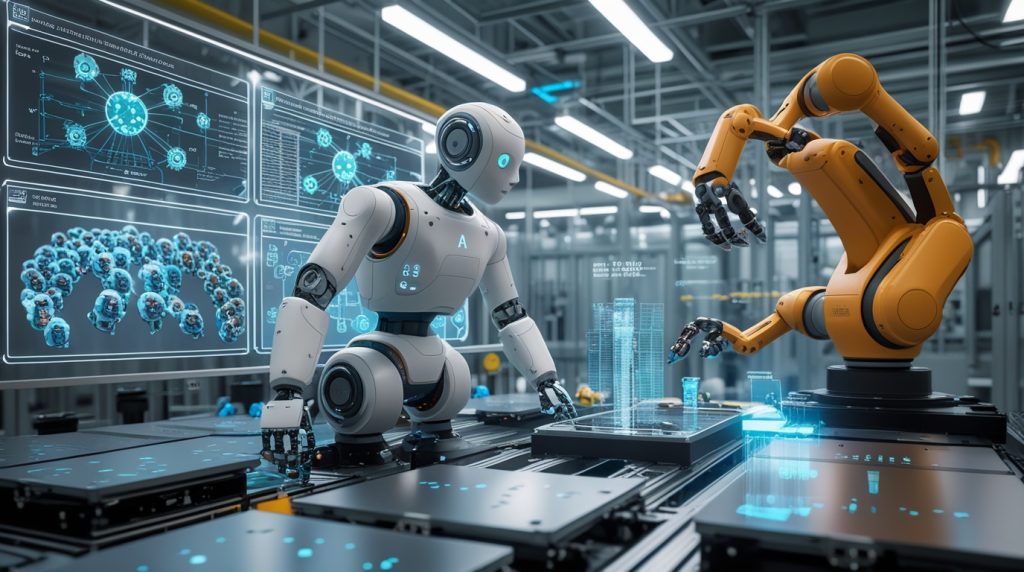In a quiet laboratory, a robotic arm trained without domain randomization in industrial robotics—perfectly sorting identical blue cubes for weeks—suddenly froze when presented with a crumpled paper bag. This simple failure reveals a multi-billion dollar challenge in industrial automation.
The Unseen Problem Crippling Smart Factories: Why Domain Randomization in Industrial Robotics Matters
Walk through any modern manufacturing facility or warehouse, and you’ll witness a paradox: sophisticated robots perfectly execute repetitive tasks yet struggle dramatically with the natural variation of everyday objects. This limitation confines automation to structured environments while keeping many complex operations reliant on human labor.
The core issue is what roboticists call the sim-to-real gap—the jarring disconnect between the orderly virtual worlds where robots train and the messy reality where they operate. As Lucía Güitta-López, a researcher at Comillas Pontifical University, explains: “Collecting data often involves considerable time and economic effort that is unaffordable in most cases. Fortunately, devices like robots can be trained with synthetic experience thanks to virtual environments” .
Until recently, this fundamental challenge forced companies to choose between expensive real-world training that risked damage to equipment and products, or overly rigid automation that failed when confronted with unexpected variations. But 2025 has delivered a breakthrough solution with surprisingly familiar origins.
What Is Domain Randomization? The “Randomized Loot” Solution for Robots

The gaming concept of “randomized loot”—where players encounter unpredictable item variations—has inspired a revolutionary approach in robotics called domain randomization. Here’s how it works:
In traditional robotic training, a system might practice picking up the same perfect blue cube thousands of times. With domain randomization, the virtual training environment constantly changes the cube’s size, color, texture, weight, and physics properties—creating what amounts to a “loot table” of infinite variations .
The technique applies this variability across multiple dimensions:
- Visual properties: Color, texture, lighting conditions
- Physical parameters: Size, weight, friction coefficients, deformation
- Environmental factors: Background clutter, camera angles, obstacle positions
Research demonstrates that “randomizing certain variables during simulation-based training significantly mitigates” the sim-to-real transfer problem. One study recorded “around 25% when diversity is introduced in the training process”—a dramatic improvement that “can be translated into a decrease in the required real experience for the same final robustness performance” .
Why Randomization Beats Perfect Simulation for Industrial Robotics
The “Spherical Cow” Principle of Robot Learning
Physicists often joke about modeling complex systems by first imagining a “spherical cow”—a simplified representation that captures essential behaviors without unnecessary complexity. Similarly, domain randomization embraces intentionally imperfect simulations rather than chasing photorealistic virtual environments .
This counterintuitive approach works because it prioritizes functional robustness over visual fidelity. By exposing AI systems to countless variations during training, they develop generalized capabilities rather than memorizing specific solutions. As one analysis of gaming loot systems notes: “For many systems, most players will never move beyond a basic probabilistic understanding so modeling more complexity is a waste of time” . The same principle applies to industrial robots—they need to handle variability, not understand its origins.
Beating the “Reality Gap” with Controlled Chaos
The progressive neural network (PNN) architecture has emerged as a particularly effective framework for implementing domain randomization. PNNs use “a single big neural model trained with synthetic experience (the virtual column of the PNN) connected with as many light neural models as required to tackle real-world problems (the real columns of the PNN)” .
This approach enables robots to build on broad virtual training while efficiently adapting to specific real-world conditions with minimal additional data. The combination of PNNs and domain randomization represents what researchers call a “promising” hybrid approach that maximizes training efficiency while ensuring operational robustness .
Where Industrial AI Is Deploying “Randomized Loot” Today
Material Handling Breakthroughs
The bulk material handling sector—involving operations like cargo ship unloading, waste sorting, and construction—has become a testing ground for these techniques. These environments present extreme variability in object size, shape, weight, and material composition .
Recent research demonstrates how reinforcement learning-based systems now select optimal “attack points” on material piles to maximize removal efficiency while managing the complex dynamics of underactuated grippers. These systems have achieved performance levels “comparable to experienced human operators” in tasks like truck loading and pile management .
Quality Inspection and Beyond
Beyond physical manipulation, the principles of variability training are transforming industrial quality control. Automated optical inspection has emerged as the leading industrial AI use case, accounting for approximately 11% of applications—far surpassing generative AI-based applications in manufacturing settings .
Companies like Pegatron have achieved remarkable results, with reported defect detection accuracy of 99.8% and “4x improvement in throughput” using AI systems trained on diverse visual examples .
Table: Industrial AI Applications Benefiting from Variability Training
How Companies Are Implementing Variability-Trained Systems

The Software Architecture Behind the Magic
Effective variability management requires sophisticated software architectures. Robotics companies are increasingly adopting software product line engineering approaches that allow “robotic applications to operate robustly in dynamic environments, which are often only partially known and controllable” .
These systems use multiple mechanisms to handle variability:
- Configuration files to conditionally load software components
- Behavior trees and finite-state machines to specify mission and adaptation rules
- Hardware abstraction layers to decouple software from specific robotic platforms
The goal is to create “software components—completely decoupled from hardware—with harmonized and standardized interfaces, and organized in an ecosystem shared among various companies” .
Building the Data Infrastructure
Successful implementations require robust data architectures. According to industrial AI analysis, manufacturers are moving away from “fragmented data systems” toward unified approaches, with the industrial DataOps market growing at 49% CAGR until 2028 .
These modern data platforms enable the cleaning, contextualization, and orchestration of operational data flows essential for training variability-resistant AI systems. Companies like Litmus and Cognite offer platforms that support “locally hosted small language models” and “low-code agent composers” for creating tailored AI agents .
The Business Impact: Why This Matters Beyond the Lab
Quantifying the ROI
The industrial AI market reached $43.6 billion in 2024 and is projected to grow at 23% CAGR to $153.9 billion by 2030 . Within this expansion, capabilities for handling variability represent a crucial competitive advantage.
Companies implementing these solutions report substantial financial benefits. Renault SA reported €270 million in savings on energy and maintenance in a single year through AI deployment, while Georgia-Pacific captured “hundreds of millions of dollars in annual value” through AI projects .
Overcoming Implementation Hurdles
Despite promising results, manufacturers face significant challenges in adoption. Research indicates that “lack of internal expertise or knowledge” is the top barrier to AI adoption, cited by 45% of manufacturers .
In response, leading companies are investing heavily in employee upskilling, with 60% of manufacturers actively investing in training existing employees for AI capabilities . Toyota’s establishment of a Software Academy with approximately 100 training courses exemplifies this trend .
The Future of Variability-Trained Robotics

Emerging Trends and Technologies
The field continues to evolve rapidly, with several key developments on the horizon:
- Hybrid PNN-DR architectures that combine progressive neural networks with domain randomization
- Industrial agentic AI that can autonomously adapt to novel variations
- Standardized component interfaces to foster software reuse across robotic platforms
- Generative AI for synthetic training data creation to expand variability further
Strategic Implications for Manufacturers
For industrial companies, these advancements signal a shift toward more adaptable, resilient automation systems. As one research team notes, “Planning and realizing variability for specific requirements and implementing robust abstractions permit robotic applications to operate robustly in dynamic environments, which are often only partially known and controllable” .
This capability becomes increasingly vital as manufacturers face growing demands for customization and flexible production. Where traditional automation excelled at mass production of identical items, variability-trained systems enable the economic production of highly customized goods—potentially revolutionizing manufacturing economics.
FAQs: Addressing Common Questions About Randomized Training in Robotics
How does domain randomization differ from traditional robot training?
Traditional robot training typically focuses on perfecting performance in consistent, predictable environments. Domain randomization intentionally introduces variations during training—much like exposing a system to “randomized loot” in gaming—to build robust capabilities that transfer better to real-world conditions where perfect consistency never exists .
What tangible business benefits does this approach deliver?
Companies report significant improvements in implementation efficiency and operational flexibility. Research shows randomization can provide “around 25% increase in the model’s accuracy,” which translates to reduced real-world training requirements and faster deployment . Additionally, businesses achieve substantial cost savings, with some organizations reporting hundreds of millions of dollars in annual value capture from AI implementations .
Are there specific industries where this approach shows particular promise?
What are the implementation challenges for variability-trained systems?
Key challenges include data architecture modernization, as these systems require clean, contextualized data from multiple sources; skills gaps, with 45% of manufacturers citing lack of internal expertise as the primary adoption barrier; and system integration complexity, particularly in connecting AI systems with existing operational technology .
How does this technology impact human workers in industrial settings?
Rather than simply replacing workers, these systems typically augment human capabilities by handling repetitive variable tasks while enabling people to focus on exception handling and strategic oversight. Toyota’s Smart Factory vision exemplifies this approach: “for AI to augment humans, i.e., to extend and retain human expertise by empowering workers” .
Fast Facts
Inspired by gaming’s “randomized loot” concept, domain randomization trains robots in endlessly variable virtual environments instead of perfect simulations. This counterintuitive approach builds robust real-world capabilities, with research showing 25% accuracy improvements. The technique is transforming industrial applications from material handling to quality inspection, helping close the $153.9 billion industrial AI market’s adaptability gap.
Want to stay ahead in the rapidly evolving field of industrial AI? Subscribe to our newsletter for monthly insights on how adaptive robotics are transforming manufacturing and logistics.



